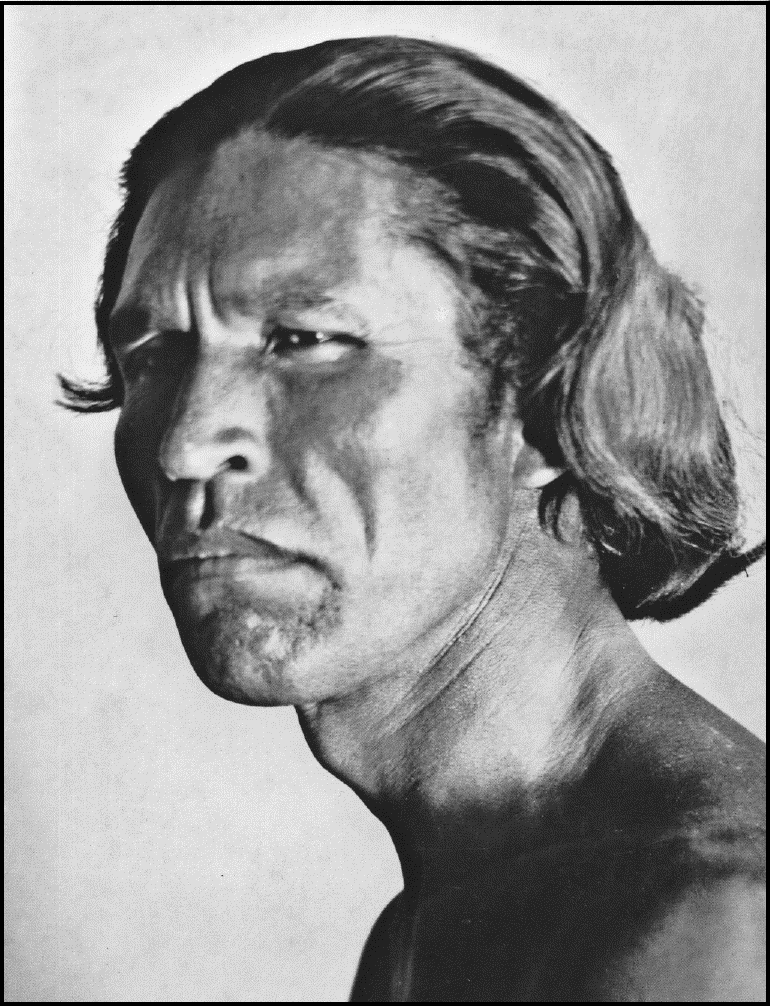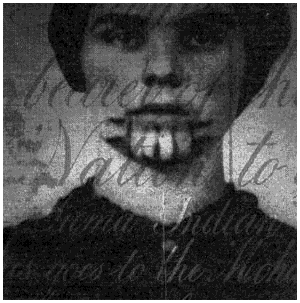The Life of Olive Oatman
Margot Mifflin
(University of Nebraska)

The Mohaves lived along the Colorado River, in the desert area between what is now Arizona and California. During the next four years of her captivity, the Indians tattooed her face --- five vertical blue lines down her chin --- and, fed her and clothed her. Later at age nineteen, she was "rescued" and returned to white civilization. But with her tattoo, she was literally, for the rest of her life, a marked woman.
In The Blue Tattoo, the Mohaves come off as being the good guys ... the original Noble Savages. They are tall, stately, and humorous. One contemporary wrote that they moved "with the dignity of princes."
- They appear to be intelligent, and to have naturally pleasant dispositions. The men are tall, erect, and finely proportioned ... their eyes are large, shaded by long lashes ... Their bodies and limbs were tinted and oiled so as to appear like well-polished mahogany.
One observer wondered "How long will it now be before a reason is found or invented for beginning a war of extermination against the hitherto peaceful Indians of the valley of the Colorado?" The author provides the answer: Within five years the tribe was but "footprints in the sand."
It seems the author --- and now, your reviewer --- are in love with the Mohaves. Olive Oatman might have succumbed to their charms as well. After all, they saved her from the Apache Yavapais who, it was rumored, were fond of "roasting girls." One Mohave not only cared for Olive during a famine, but, in secret, fed her, kept her alive while others around her were half-starved.
The Indians named her "Spantsa" --- a rather salacious Mohave word having to do with unquenchable lust. The name, among other things, makes Mifflin suspect that the young woman might have fallen in love if not in bed with one or more of the Indians she lived with for more than five years.
Shortly after her "rescue," Oatman was put on the American lecture circuit. Her kidnapping and recovery, as well as her tattoo, were a natural draw. Unlike the present, tattooed ladies were not all that common in the United States (the tattoo machine itself was not invented until 1891.)
Moreover, an ambitious Methodist minister named Royal Byron Stratton wrote a sensational account of her time with the Indians, told of their "degradation, the barbarity, the superstition, the squalidness, that curse the uncounted thousands who people the caverns and wilds." Thus he not only degraded the very Indians who had saved her, but --- by spicing up Oatman's life among the savages --- was able to turn the book Life Among the Indians into a best-seller.
Stratton, being a Methodist, was a little potty, but, fortunately for all involved, went completely mad in his late years, and had to be salted away. Oatman had been traveling with him and telling her story, but by the time he went bonkers she had become a competent public speaker on her own and stayed on the circuit until she retired to Sherman, Texas, in 1875.
In her later years, it seems that Olive was profoundly depressed, suffering from what they called "neurasthenia." It might have been because of her being kidnapped by the Indians (or away from them), but watching the Yavapais murder her mother, father and brothers and sisters might have contributed to her delicate health.
 According to the author, there are no end of "captive" and "marked women outsiders" titles on the shelves. The women are uniformly presumed to be scarred by their experience, either physically or emotionally. Some, like Oatman, also carried physical marks of their captivity.
According to the author, there are no end of "captive" and "marked women outsiders" titles on the shelves. The women are uniformly presumed to be scarred by their experience, either physically or emotionally. Some, like Oatman, also carried physical marks of their captivity.
In an interesting Epilogue, Mifflin cites episodes in the TV series Death Valley Days as well as Oatman-like characters in the writings of Elmore Leonard and Elizabeth Grayson. She even quotes from The Scarlet Letter: Hester Prynne, after all, was marked with the letter "A," carrying it within and without.
The Blue Tattoo is a fascinating study not only of the culture of the Mohaves, but of changes in the Oatman-inspired story of "the tattooed captive." It evidently became a popular myth told in circuses towards the end of the 18th century. Victims of kidnapping by the "redskins" offered "the notion that people of color could transform whites into people of color --- ethnically and decoratively, as a means of exploitation and degradation."
One of the factoids thrown out by the writer is the revelation that all states admitted to the union after the original thirteen were allowed to set conditions on their admission; like Texas being able, at any time, to convert itself into five separate states (which is something that the rest of us might want to work on, so we can all be done with the Bushes and their clan once and for all).
The condition that Oregon set for its admission was that all blacks would be banned from the state for all time. "Oregon was the only state admitted to the Union with a black exclusion clause," says Mifflin. We were tempted to call and question the attorney general to discover if this were still a state policy.